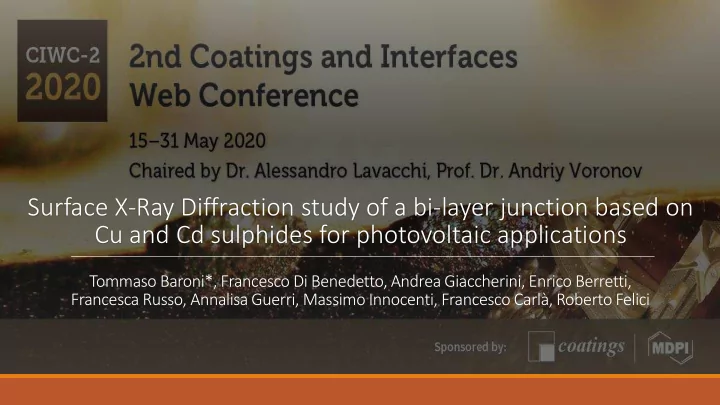

Surface X-Ray Diffraction study of a bi-layer junction based on Cu and Cd sulphides for photovoltaic applications Tommaso Baroni*, Francesco Di Benedetto, Andrea Giaccherini, Enrico Berretti, Francesca Russo, Annalisa Guerri, Massimo Innocenti, Francesco Carlà, Roberto Felici
‘What’s really warming the world’ https://www.bloomberg.com/graphics/2015-whats-warming-the-world/
https://www.nrel.gov/pv/cell-efficiency.html
EH1 - ID03 beamline
Sample preparation Ag(111) S Cd X 60 S Cu 120 E-ALD cycles X 60 (~25nm) (Cu 2 S) 60 /(CdS) 60 /Ag(111)
ҧ (CdS) 60 /Ag(111) structure vs N° Cu 2 S cycle 3.0E-03 2.5E-03 (012) CdS k-scan (012) CdS l-scan 2.34 0.68 0.675 2.335 0.67 2.33 0.665 2.5E-03 0.66 2.325 2.0E-03 0.655 0.65 2.32 0 6 12 18 24 30 36 42 48 54 60 0 6 12 18 24 30 36 42 48 54 60 0 0 2.0E-03 6 6 12 12 1.5E-03 18 18 Intensità (a.u.) Intensità (a.u.) 24 24 L 1.5E-03 30 30 36 36 42 42 1.0E-03 48 48 54 54 1.0E-03 60 60 5.0E-04 5.0E-04 ഥ 𝒎 = 𝟑. 𝟒𝟒𝟏 ± 𝟏. 𝟏𝟏𝟒 𝐬. 𝐦. 𝐯. 𝒍 = 𝟏. 𝟕𝟕𝟖 ± 𝟏. 𝟏𝟏𝟒 𝐬. 𝐦. 𝐯. l (r.l.u.) k (r.l.u.) 0.0E+00 0.0E+00 2.23 2.236 2.242 2.248 2.254 2.26 2.266 2.272 2.278 2.284 2.29 2.296 2.302 2.308 2.314 2.32 2.326 2.332 2.338 2.344 2.35 2.356 2.362 2.368 2.374 2.38 2.386 2.392 2.398 2.404 2.41 2.416 2.422 2.428 2.434 2.44 0.628 0.631 0.634 0.637 0.64 0.643 0.646 0.649 0.652 0.655 0.658 0.661 0.664 0.667 0.67 0.673 0.676 0.679 0.682 0.685 0.688 0.691 0.694 0.697 0.7 0.703 0.706 0.709
(CdS) 60 /Ag(111) 2-D BINoculars map Greenockite 𝑸𝟕 𝟒 𝒏𝒅 𝑏 = 𝑐 = 𝟓. 𝟐𝟒𝟖 Å; 𝑑 = 𝟕. 𝟖𝟐𝟓 Å 𝛽 = 𝛾 = 90°; 𝛿 = 120° L V = 𝟘𝟘. 𝟔𝟑 Å 𝟒 (CdS) 60 /Ag(111) ? 𝑏 = 𝑐 = 𝟓. 𝟒𝟒𝟑 Å; 𝑑 = 𝟕. 𝟏𝟖𝟔 Å 𝛽 = 𝛾 = 90°; 𝛿 = 120° V = 𝟘𝟗. 𝟖𝟒 ± 𝟏. 𝟒𝟖 Å 𝟒
(Cu 2 S) 60 /(CdS) 60 /Ag(111) (Cu 2 S) 60 /Ag(111) (MA3071) (ma2082) k (rlu) k (rlu) L h’ ( rlu) h’ ( rlu)
( 0 0.73 0.2-6 ) Cu S l-scan and Cu 2 S cell parameters Cu 2 S (Cu (Cu 2 S) S) 60 60 /( /(CdS) 60 60 /Ag(111) MA3071 𝑏 = 𝑐 = 27.41 ± 0.04 Å; 𝑑 = 6.76 ± 0.03 Å 𝛽 = 𝛾 = 90°; 𝛿 = 120° 𝑑 𝑑ℎ𝑏𝑚𝑑𝑝𝑑𝑗𝑢𝑓 = 13.494 Å
Conclusions - MA3071 is the first in-situ SXRD experiment which features an E-ALD bi-layer junction of Cu 2 S/CdS/Ag(111). - The SXRD in-situ analysis highlights the profound epitaxial relationship existing between the films and the bulk, consequent to the homogenisation of the metrics of the CdS and the Cu 2 S structures to values commensurate to the surface periodicity of the substrate. - The (CdS) 60 /Ag(111) develops an elementary cell with crystallographic axes parallel to those of the surface cell of the Ag(111); the comparison with the structure of greenockite suggests a compensation mechanism related to the L strain imposed by the film growth on the crystallographic Ag(111) surface. - The positions in the reciprocal space of the Cu 2 S reflections is compatible with an pseudo-hexagonal pattern rotated by 30 ° with respect to the surface cell cell of the substrate; the data suggest a hexagonal chalcocite-like structure with a planarization of the S layers, as a result of the strong epitaxial relationship existing with the CdS below and as already noticed in relation to a Cu 2 S/Ag(111) E-ALD deposit by Giaccherini et al. (1). - This study confirms E-ALD as an energy efficient method for the growth of semiconducting heterostructures with tailored properties using low cost/environmental-impact materials. 1) Giaccherini et al. (2017), Scientific Reports | 7: 1615 | DOI:10.1038/s41598-017-01717-0
Recommend
More recommend